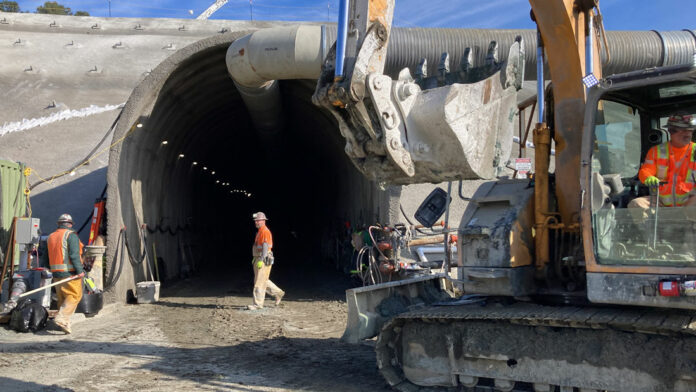
Valley Water crews have dug about 160 feet into a giant tunnel that will be able to divert massive volumes of water out of Anderson Reservoir when the Anderson Dam Seismic Retrofit Project is completed.
The 20-foot diameter tunnel—which will be 1,750 feet long when completed—will also serve a key purpose during the long-term construction of a new earthen dam embankment that the water district has been planning for more than 10 years.
“We need that tunnel to move the water (remaining in the reservoir) during the construction of the dam retrofit project, around the construction site…when we rebuild the embankment,” said Valley Water Assistant Officer of Dam Safety Ryan McCarter.
That rebuilding won’t begin until the tunnel is finished, in 2024 at the earliest, McCarter said. Crews began tunneling at the site on Nov. 9, and are currently digging about 10 feet of tunnel length per day.
McCarter and other Valley Water officials gave members of the news media a tour of the tunnel construction site Dec. 15. Giant dump trucks full of excavated dirt made repeated trips from the tunnel opening at the bottom of the dam up to the boat launch parking lot above the reservoir. That dirt will likely be reused to fill in the new dam embankment when that stage of the project begins.
Inside the tunnel, crews used heavy equipment to install metal arches and other materials to reinforce the underground walls.
The tunnel will go all the way through the bottom of the dam and into the floor of Anderson Reservoir, about 30 feet below the current water level, McCarter explained. When crews approach the end of the tunnel inside the reservoir, they will perform a sophisticated “lake tap” procedure to carefully open the underwater earth.
When the tunnel is complete, it will be outfitted with a 13-foot diameter pipe that will be capable of moving up to 6,000 cubic feet of water per second into Coyote Creek out of Anderson Reservoir when it is full or reaching capacity, McCarter added. That will be important in case of an emergency such as an earthquake or heavy rain storm, allowing Valley Water to move much more water out of the reservoir to prevent overflowing and flooding beyond the water body’s shores.
One such emergency in recent memory occurred in February 2017, when a series of torrential storms sent Anderson Reservoir’s waters over the existing spillway, flooding Coyote Creek and residential properties all the way up to San Jose.
The reservoir’s old outlet can only release a maximum of about 450 cfs.
Construction of the new seismically safe dam embankment will begin soon after the tunnel is complete, and will be under construction until 2032, McCarter said.
In October, Valley Water crews and contractors prepared for the tunnel construction by building a giant “soil nail” wall around the 20-foot outlet on the outside of Anderson Dam. The wall is composed of 244 rebar soil nails, arranged in a grid pattern, that were driven 120 feet deep into the ground before they were reinforced with concrete, Valley Water staff said.
Also completed earlier this year is an “outlet works drop shaft,” which, combined with the diversion tunnel, will allow Valley Water to quickly drain up to 30% of Anderson Reservoir’s capacity within seven days to prevent downstream flooding if the water body threatens to overflow any time in the future.
The entirety of the Anderson Dam Seismic Retrofit Project, including the tunnel and related infrastructure, is projected to cost about $576 million.
The project became necessary after state authorities in 2009 determined that Anderson Dam would not withstand a major earthquake, and the crest of the dam could slump in such an event—leaving Morgan Hill underwater within minutes.
Anderson Reservoir has been almost completely empty since the district began draining it in 2020 in order to allow the current and ongoing construction. As of Dec. 16, Anderson Reservoir is at about 3.7% of its total capacity, according to Valley Water’s website. When full, the reservoir can hold 89,278 acre feet of water.

The existing dam embankment was built in 1950. “There are some seismic concerns with the materials used to build the embankment back then,” McCarter said.
Valley Water Board of Directors Interim Chair John Varela said at the Dec. 15 media tour that the Anderson Dam project will help the district with two crucial goals—reliable drinking water supplies and safety from flooding. Anderson Reservoir is the largest of Valley Water’s 10 water storage bodies throughout Santa Clara County.
“We’re very pleased that we’re moving forward as expeditiously as we can,” Varela said.
When fully operational, Anderson Reservoir will store water that can either be transported by pipeline to treatment facilities north of Morgan Hill, or released into Coyote Creek and nearby percolation ponds for natural filtration into the groundwater basin, according to Valley Water staff.











